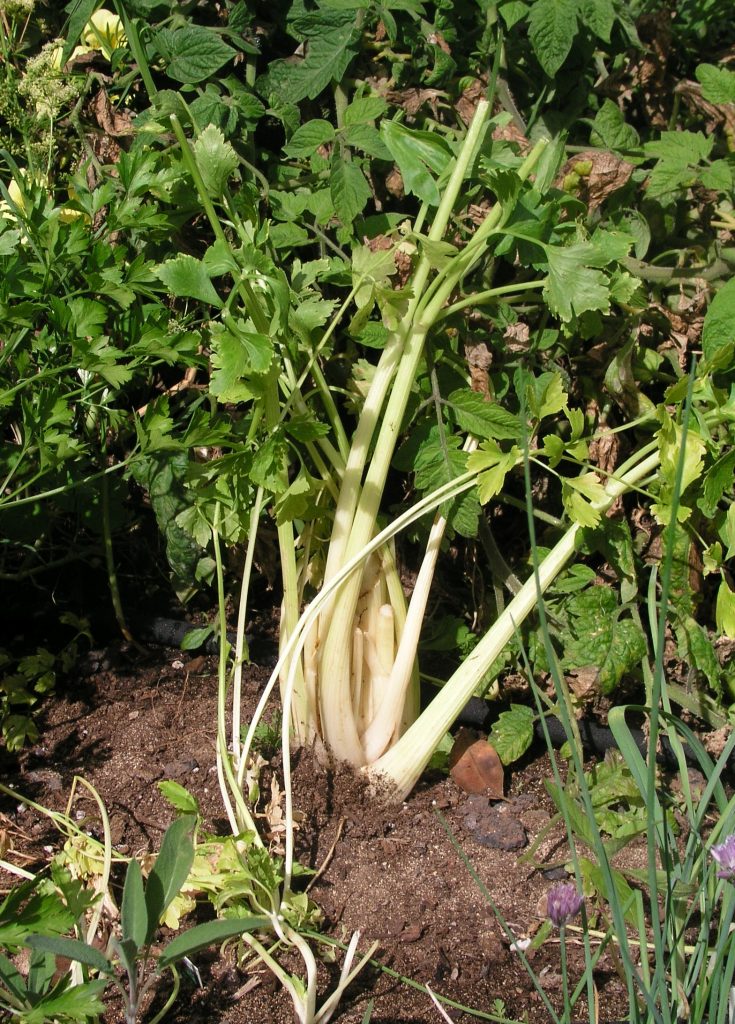Celery: Beyond Sticks & Peanut Butter

Blanched celery ready to be harvested in the author’s garden; new shoots have already been planted (foreground). PC: J.M. Buck.
There’s more to celery than just sticks and peanut butter.
One time I heard someone describe celery as “useless.” Not true.
Though most of us think of celery as a simple food used as a culinary additive or served raw with dip, did you know that it not a vegetable, but an herb that was originally grown for medicinal purposes? That’s right.
Though celery (Apium graveolens) has an 88% water content, the combination of stems, roots and leaves are well-balanced with nutrients, vitamins and minerals. One hundred grams of celery leaves alone (which also consist of what we think of as the “stalk”) contain 6.3% protein, .6% fat, 2.1% minerals, 1.4% fiber and 1.6% carbohydrates. They also contain riboflavin, niacin, phosphorous, carotene, vitamin C and iron.
From ancient times until today, celery has been used to treat a long list of ailments, including insomnia, arthritis, gout, anemia, Hodgkin’s disease, leukemia and respiratory ailments such as asthma, bronchitis and tuberculosis. The seeds help alleviate indigestion.
Celery is believed to be endemic to the Mediterranean region, though a number of other countries also claim its origination.
The Greeks believed celery to be a holy plant, and the earliest historical mention of celery is in 800 BCE, when it was referred to in Homer’s Odyssey as selinon. Celery has even been found in ancient Egyptian tombs.
Celery came into use as a food in 15th-century France. The culinary trend soon caught on in Italy, where our modern uses for celery were developed.
Celery first arrived in the United States in the 1850s when Scotsman George Taylor brought seeds to Kalamazoo, Michigan. He served it at an upper crust ball, and its unique and pleasant flavor garnered attention. It wasn’t long before Kalamazoo became the “Celery Capital” of the U.S. After a devastating blight in the 1930s destroyed Midwest celery crops, California became the nation’s largest producer of celery and remains so today.
Celery grows quite easily on all the Hawaiian Islands. Since it requires water in abundance, it thrives on the windward sides, especially in the lower elevations. Patience is necessary when raising celery, as it requires a long growing season of 120 to 140 days.
Celery leaves, which include the stalks, grow directly from a thick, tuberous root. Like most vegetables, it requires a rich, friable loam enriched with a lot of compost.
To grow from seed, sprinkle the tiny seeds onto a flat filled with a good organic potting soil. Sprinkle a very thin layer of soil over the seeds and tamp lightly. Do not water with a hose or a watering can, as this will disturb the seeds too much. Instead, soak soil with a misting bottle or set the flat in a tray of water and allow it to soak the soil from the bottom up.
Once the seedlings have their first “real” leaves and roots are visible in the flat’s drainage holes, transplant the young plants into the ground. Choose a sunny location protected from strong wind. Allow one foot spacing between plants in rows two feet apart.
Celery is best harvested when about a foot tall. Some people prefer to blanch the plant about three weeks before harvesting to prevent bitterness. To accomplish this, shade the stalks by placing boards on either side of the rows, or by putting cardboard boxes or milk cartons around the sides of the plants. The down side to this practice is that because shading inhibits the production of chlorophyll, the nutritive value of the plant is diminished.
To harvest, clip the thick root about half-an-inch below the ground. Celery produces keiki on the sides of the mother plant; these can be clipped off and replanted, much like you would propagate irises or lilies. After replanting the keiki, water thoroughly.
Happy gardening!








